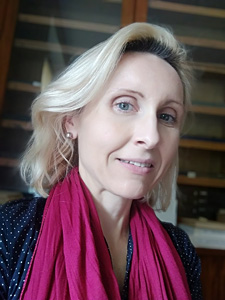Mgr Magda Kapcia
Asystent

Zainteresowania badawcze
- Archeobotanika, w szczególności historia roślin jadalnych i użytkowych, chwastów i roślin inwazyjnych.
- Rekonstrukcja zbiorowisk roślinnych ze stanowisk archeologicznych.
- Przemiany antropogeniczne paleośrodowiska.
- Paleodieta.
Najnowsze publikacje (wybrane)
Kapcia M., Korczyńska-Cappenberg M., Lityńska-Zając M., Wacnik A., Głód A., Moskal-del Hoyo M. 2024. Plant cultivation and diversity at the Early Neolithic settlement in Biskupice in Poland. Scientific Reports 14: 20393. DOI
Moskal-del Hoyo M., Korczyńska-Cappenberg M., Kenig R., Rauba-Bukowska A., Roffet-Salque M., Maule C.A., Werra D.H., Hughes R.E., Kapcia M., Wilczyński J., Czekaj-Zastawny A., Głód A., Nowak M. 2024. An Early Neolithic house in the Foothills: A case study of pottery and lithic artefacts from the Biskupice site 18 (Wieliczka Foothills, southern Poland). Journal of Archaeological Science: Reports 53: 104346. DOI
Filipović D., Jones G., Kirleis W., Bogaard A., Ballantyne R., Charles M., de Vareilles A., Ergun M., Gkatzogia E., Holguin A., Hristova I., Karathanou A., Kapcia M., Knežić D., Kotzamani G., Lathiras P., Livarda A., Marinova E., Michou S., Mosulishvili M., Mueller-Bieniek A., Obradović D., Padgett M., Paraskevopoulou P., Petridou C., Stylianakou H., Zerl T., Vidas D., Valamoti S.M. 2023. Triticum timopheevii s.l. (‘new glume wheat’) finds in regions of southern and eastern Europe across space and time. Vegetation History and Archaeobotany in press. DOI
Korczyńska-Cappenberg M., Nowak M., Mueller-Bieniek A., Wilczyński J., Pospuła S., Wertz K., Kalicki T., Biesaga P., Szwarczewski P., Kapcia M., Cappenberg K., Wacnik A., Moskal-del Hoyo M. 2023. Middle Neolithic agricultural and land-use models in southern Poland: A case-study of the long-term settlement in Mozgawa. The Holocene 33: 619–635. DOI
Moskal-del Hoyo M., Kapcia M., Aurélie A., Alexandrowicz W.P., Saile T., Kiosak D., Dębiec M. 2023. Archaeobotanical and palaeoenvironmental analyses from the easternmost Early Neolithic sites at Kamyane-Zavallia (Ukraine) and Nicolaevca V (Moldova). Vegetation History and Archaeobotany in press. DOI
Mueller-Bieniek A., Moskal-del Hoyo M., Korczyńska-Cappenberg M., Kapcia M., Nowak M. 2023. Plant macro-remains from a large middle Neolithic settlement in SE Poland – Internal diversification and possible status of the settlers. Journal of Archaeological Science: Reports 49: 104016. DOI
Filipović D., Meadows J., Corso M.D., Kirleis W., Alsleben A., Akeret Ö., Bittmann F., Bosi, G., Ciută B., Dreslerová D., Effenberger H., Gyulai F., Heiss A.G., Hellmund M., Jahns S., Jakobitsch T., Kapcia M., Klooß S., Kohler-Schneider M., Kroll H., Makarowicz P., Marinova E., Märkle T., Medović A., Mercuri A.M., Mueller-Bieniek A., Nisbet R., Pashkevich G., Perego R., Pokorný P., Pospieszny Ł., Przybyła M., Reed K., Rennwanz J., Stika H.-P., Stobbe A., Tolar T., Wasylikowa K., Wiethold J., Zerl, T. 2020. New AMS 14 C dates track the arrival and spread of broomcorn millet cultivation and agricultural change in prehistoric Europe. Scientific Reports 10: 13698. DOI
Mueller-Bieniek A., Pyzel J., Kapcia M. 2020. Chenopodium seeds in open-air archaeological sites – How to not throw the baby out with the bathwater. Environmental Archaeology 25: 69–81. DOI
Kapcia M., Mueller-Bieniek A. 2019. An insight into Bronze Age subsistence strategy in forested Carpathian foothills, based on plant macro-remains. Archaeological and Anthropological Sciences 11: 2879–2895. DOI
Mueller-Bieniek A., Bogucki P., Pyzel J., Kapcia M., Moskal-del Hoyo M., Nalepka D. 2019. The role of Chenopodium in the subsistence economy of pioneer agriculturalists on the northern frontier of the Linear Pottery culture in Kuyavia, central Poland. Journal of Archaeological Science 111: 105027. DOI
Nowak M., Wilczyński J., Wróbel J., Kapcia M., Moskal-del Hoyo M. 2019. The Baden Culture finds from Goszcza site 1 (Kielnik): new archaeological, anthropological, archaeozoological and archaeobotanical data. Folia Quaternaria 87: 27–58. DOI
Wilczyński J., Nowak M., Mueller-Bieniek A., Kapcia M., Moskal-del Hoyo M. 2019. Unexpected discovery of the Funnel Beaker culture feature at the Kraków Spadzista (Kraków-Zwierzyniec 4) site. Folia Quaternaria 87: 5–26. DOI
Moskal-del Hoyo M., Mueller-Bieniek A., Alexandrowicz W.P., Wilczyński J., Wędzicha S., Kapcia M., Przybyła M.M. 2017. The continuous persistence of open oak forests in the Miechów Upland (Poland) in the second half of the Holocene. Quaternary International 458: 14–27. DOI







